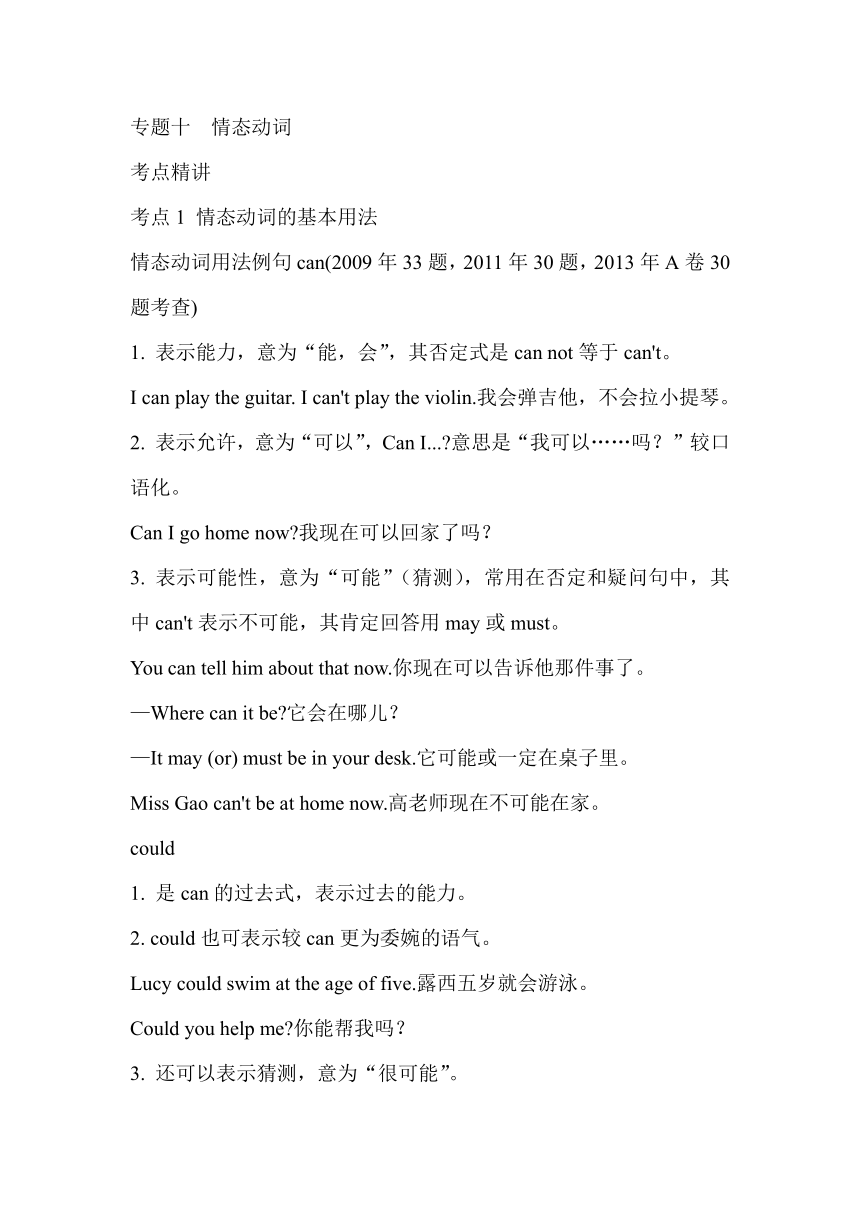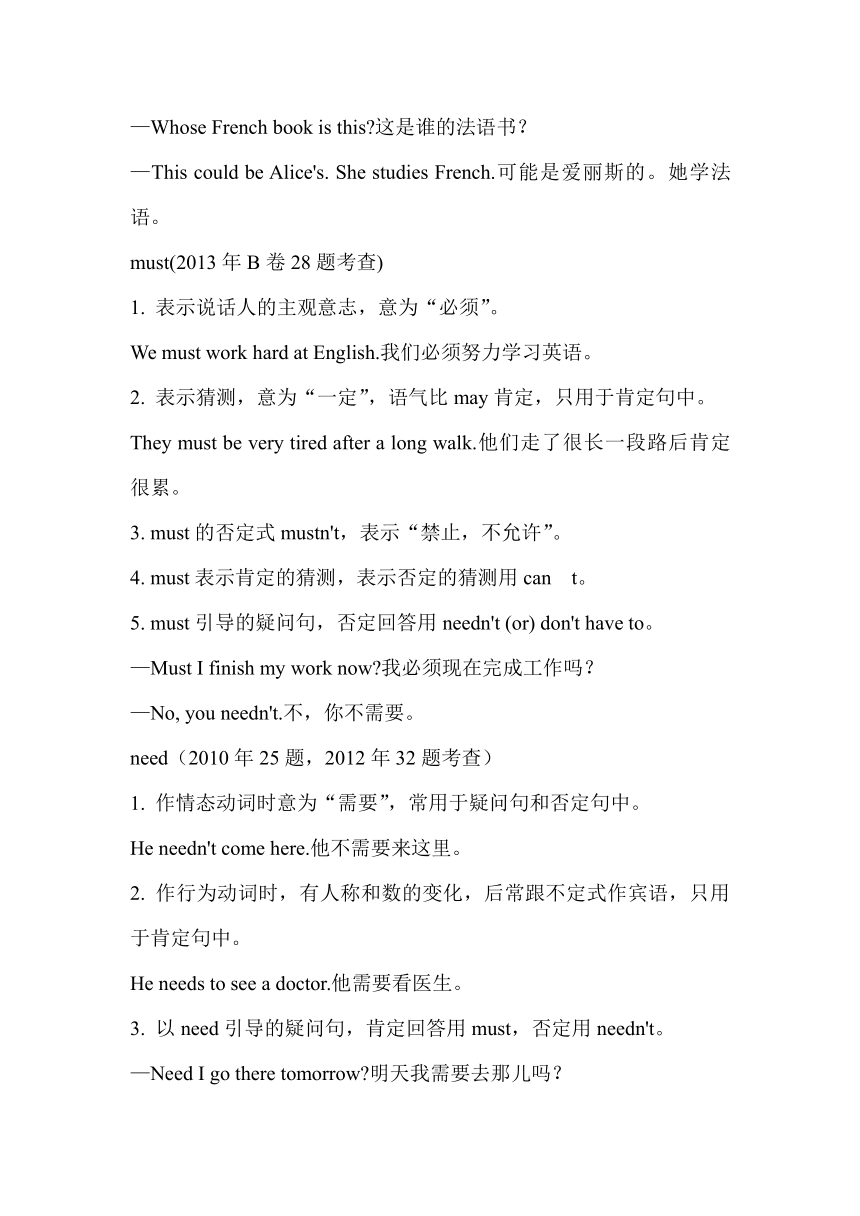2014届(仁爱湘教版)重庆市中考考点解密:【专题十】情态动词
文档属性
| 名称 | 2014届(仁爱湘教版)重庆市中考考点解密:【专题十】情态动词 |  | |
| 格式 | zip | ||
| 文件大小 | 6.3KB | ||
| 资源类型 | 教案 | ||
| 版本资源 | |||
| 科目 | 英语 | ||
| 更新时间 | 2014-04-23 09:05:14 | ||
图片预览


文档简介
专题十 情态动词
考点精讲
考点1 情态动词的基本用法
情态动词用法例句can(2009年33题,2011年30题,2013年A卷30题考查)
1. 表示能力,意为“能,会”,其否定式是can not等于can't。
I can play the guitar. I can't play the violin.我会弹吉他,不会拉小提琴。
2. 表示允许,意为“可以”,Can I...?意思是“我可以……吗?”较口语化。
Can I go home now?我现在可以回家了吗?
3. 表示可能性,意为“可能”(猜测),常用在否定和疑问句中,其中can't表示不可能,其肯定回答用may或must。
You can tell him about that now.你现在可以告诉他那件事了。
—Where can it be?它会在哪儿?
—It may (or) must be in your desk.它可能或一定在桌子里。
Miss Gao can't be at home now.高老师现在不可能在家。
could
1. 是can的过去式,表示过去的能力。
2. could也可表示较can更为委婉的语气。
Lucy could swim at the age of five.露西五岁就会游泳。
Could you help me?你能帮我吗?
3. 还可以表示猜测,意为“很可能”。
—Whose French book is this?这是谁的法语书?
—This could be Alice's. She studies French.可能是爱丽斯的。她学法语。
must(2013年B卷28题考查)
1. 表示说话人的主观意志,意为“必须”。
We must work hard at English.我们必须努力学习英语。
2. 表示猜测,意为“一定”,语气比may肯定,只用于肯定句中。
They must be very tired after a long walk.他们走了很长一段路后肯定很累。
3. must的否定式mustn't,表示“禁止,不允许”。
4. must表示肯定的猜测,表示否定的猜测用can?t。
5. must引导的疑问句,否定回答用needn't (or) don't have to。
—Must I finish my work now?我必须现在完成工作吗?
—No, you needn't.不,你不需要。
need(2010年25题,2012年32题考查)
1. 作情态动词时意为“需要”,常用于疑问句和否定句中。
He needn't come here.他不需要来这里。
2. 作行为动词时,有人称和数的变化,后常跟不定式作宾语,只用于肯定句中。
He needs to see a doctor.他需要看医生。
3. 以need引导的疑问句,肯定回答用must,否定用needn't。
—Need I go there tomorrow?明天我需要去那儿吗?
—Yes, you must. (or) No, you needn't.是的,你必须去。/不,不需要。
may
1. “可以”,表示许可。
—May I look at your CD player?我可以看一下你的CD机吗?
—No, you mustn't (or) can't.不,你不可以。
2. “可能”,表示可能性(猜测),常用于肯定句中。
Your sister may be waiting for you now.你的姐姐/妹妹可能现在正在等你。
3. 以may引导的一般疑问句否定回答应为can't (or) mustn't。
might是may的过去式,表示猜测,可能性比could小。
—Whose guitar is this?这是谁的吉他?
—It might belong to Alice. She plays the guitar.可能是爱丽斯的。她弹吉他。
should意为“应该”。
You should go to see the doctor.你应该去看医生。
have to 表示客观需要,意为“不得不,必须”,有人称、时态和数的变化,后跟动词原形。must与have to的区别:must表示说话人的主观看法,have to表示客观原因。
He had to stay at home because of the heavy rain.因为下大雨他不得不待在家里。
had better意为“最好……”,没有人称和数的变化,后接不带to的不定式,即动词原形。
You'd better go there by bus.你最好乘公共汽车去那儿。
情态动词用法口诀
情态动词两要点:动词原形跟后面,
说话语气较委婉;can表能力may许可;
must 代表责任与义务,否定回答须用needn't;
should应该,would愿意,have to不得不表客观。
考点2 情态动词表推测的用法
1. 肯定推测
情态动词用法
must表示肯定推测,意为“一定”,语气最强烈
They must be very tired after a long walk.
他们一定很累了,走了这么长的路。
can表示可能性could表示肯定推测,意为“很可能”
Where can my book be?我的书可能在哪里呢?
The French book could be Alice's. She studies French.这本法语书很可能是爱丽丝的。她学法语。
may表示肯定推测,意为“也许”,语气一般might表示肯定推测,意为“或许”,语气更弱如:
Your sister may be waiting for you now. 你的姐姐或妹妹可能正在等你呢。
She might have gone to the library. She likes reading books in the afternoon. 她或许去图书馆了。她下午喜欢看书。
2. 否定推测
情态动词用法can't表示否定推测,语气强烈,意为“一定不”
Miss Gao can't be in the classroom. I just saw her in the supermarket.高老师不可能在教室,我刚刚在超市看见她了。
may not表示否定推测,语气不确定,意为“可能不”
It may not be my pen. 这可能不是我的笔。
考点精讲
考点1 情态动词的基本用法
情态动词用法例句can(2009年33题,2011年30题,2013年A卷30题考查)
1. 表示能力,意为“能,会”,其否定式是can not等于can't。
I can play the guitar. I can't play the violin.我会弹吉他,不会拉小提琴。
2. 表示允许,意为“可以”,Can I...?意思是“我可以……吗?”较口语化。
Can I go home now?我现在可以回家了吗?
3. 表示可能性,意为“可能”(猜测),常用在否定和疑问句中,其中can't表示不可能,其肯定回答用may或must。
You can tell him about that now.你现在可以告诉他那件事了。
—Where can it be?它会在哪儿?
—It may (or) must be in your desk.它可能或一定在桌子里。
Miss Gao can't be at home now.高老师现在不可能在家。
could
1. 是can的过去式,表示过去的能力。
2. could也可表示较can更为委婉的语气。
Lucy could swim at the age of five.露西五岁就会游泳。
Could you help me?你能帮我吗?
3. 还可以表示猜测,意为“很可能”。
—Whose French book is this?这是谁的法语书?
—This could be Alice's. She studies French.可能是爱丽斯的。她学法语。
must(2013年B卷28题考查)
1. 表示说话人的主观意志,意为“必须”。
We must work hard at English.我们必须努力学习英语。
2. 表示猜测,意为“一定”,语气比may肯定,只用于肯定句中。
They must be very tired after a long walk.他们走了很长一段路后肯定很累。
3. must的否定式mustn't,表示“禁止,不允许”。
4. must表示肯定的猜测,表示否定的猜测用can?t。
5. must引导的疑问句,否定回答用needn't (or) don't have to。
—Must I finish my work now?我必须现在完成工作吗?
—No, you needn't.不,你不需要。
need(2010年25题,2012年32题考查)
1. 作情态动词时意为“需要”,常用于疑问句和否定句中。
He needn't come here.他不需要来这里。
2. 作行为动词时,有人称和数的变化,后常跟不定式作宾语,只用于肯定句中。
He needs to see a doctor.他需要看医生。
3. 以need引导的疑问句,肯定回答用must,否定用needn't。
—Need I go there tomorrow?明天我需要去那儿吗?
—Yes, you must. (or) No, you needn't.是的,你必须去。/不,不需要。
may
1. “可以”,表示许可。
—May I look at your CD player?我可以看一下你的CD机吗?
—No, you mustn't (or) can't.不,你不可以。
2. “可能”,表示可能性(猜测),常用于肯定句中。
Your sister may be waiting for you now.你的姐姐/妹妹可能现在正在等你。
3. 以may引导的一般疑问句否定回答应为can't (or) mustn't。
might是may的过去式,表示猜测,可能性比could小。
—Whose guitar is this?这是谁的吉他?
—It might belong to Alice. She plays the guitar.可能是爱丽斯的。她弹吉他。
should意为“应该”。
You should go to see the doctor.你应该去看医生。
have to 表示客观需要,意为“不得不,必须”,有人称、时态和数的变化,后跟动词原形。must与have to的区别:must表示说话人的主观看法,have to表示客观原因。
He had to stay at home because of the heavy rain.因为下大雨他不得不待在家里。
had better意为“最好……”,没有人称和数的变化,后接不带to的不定式,即动词原形。
You'd better go there by bus.你最好乘公共汽车去那儿。
情态动词用法口诀
情态动词两要点:动词原形跟后面,
说话语气较委婉;can表能力may许可;
must 代表责任与义务,否定回答须用needn't;
should应该,would愿意,have to不得不表客观。
考点2 情态动词表推测的用法
1. 肯定推测
情态动词用法
must表示肯定推测,意为“一定”,语气最强烈
They must be very tired after a long walk.
他们一定很累了,走了这么长的路。
can表示可能性could表示肯定推测,意为“很可能”
Where can my book be?我的书可能在哪里呢?
The French book could be Alice's. She studies French.这本法语书很可能是爱丽丝的。她学法语。
may表示肯定推测,意为“也许”,语气一般might表示肯定推测,意为“或许”,语气更弱如:
Your sister may be waiting for you now. 你的姐姐或妹妹可能正在等你呢。
She might have gone to the library. She likes reading books in the afternoon. 她或许去图书馆了。她下午喜欢看书。
2. 否定推测
情态动词用法can't表示否定推测,语气强烈,意为“一定不”
Miss Gao can't be in the classroom. I just saw her in the supermarket.高老师不可能在教室,我刚刚在超市看见她了。
may not表示否定推测,语气不确定,意为“可能不”
It may not be my pen. 这可能不是我的笔。
同课章节目录
- 词法
- 名词
- 动词和动词短语
- 动词语态
- 动词时态
- 助动词和情态动词
- 非谓语动词
- 冠词
- 代词
- 数词和量词
- 形容词副词及其比较等级
- 介词和介词短语
- 连词和感叹词
- 构词法
- 相似、相近词比较
- 句法
- 陈述句
- 一般疑问句和否定疑问句
- 特殊疑问句及选择疑问句
- 反意疑问句
- 存在句(There be句型)
- 宾语从句
- 定语从句
- 状语从句
- 主谓一致问题
- 简单句
- 并列句
- 复合句
- 主谓一致
- 主、表语从句
- 名词性从句
- 直接引语和间接引语
- 虚拟语气
- 感叹句
- 强调句
- 倒装句
- 祈使句
- 句子的成分
- 句子的分类
- 题型专区
- 单项选择部分
- 易错题
- 完形填空
- 阅读理解
- 词汇练习
- 听说训练
- 句型转换
- 补全对话
- 短文改错
- 翻译
- 书面表达
- 任务型阅读
- 语法填空
- 其他资料
